Get Your Copilot

Create Chatbot For Gmail
Transform your productivity with Copilot.Live seamless integration of ChatBot and Gmail. Automate workflows effortlessly and boost efficiency. Start your free trial today and streamline your operations like never before.
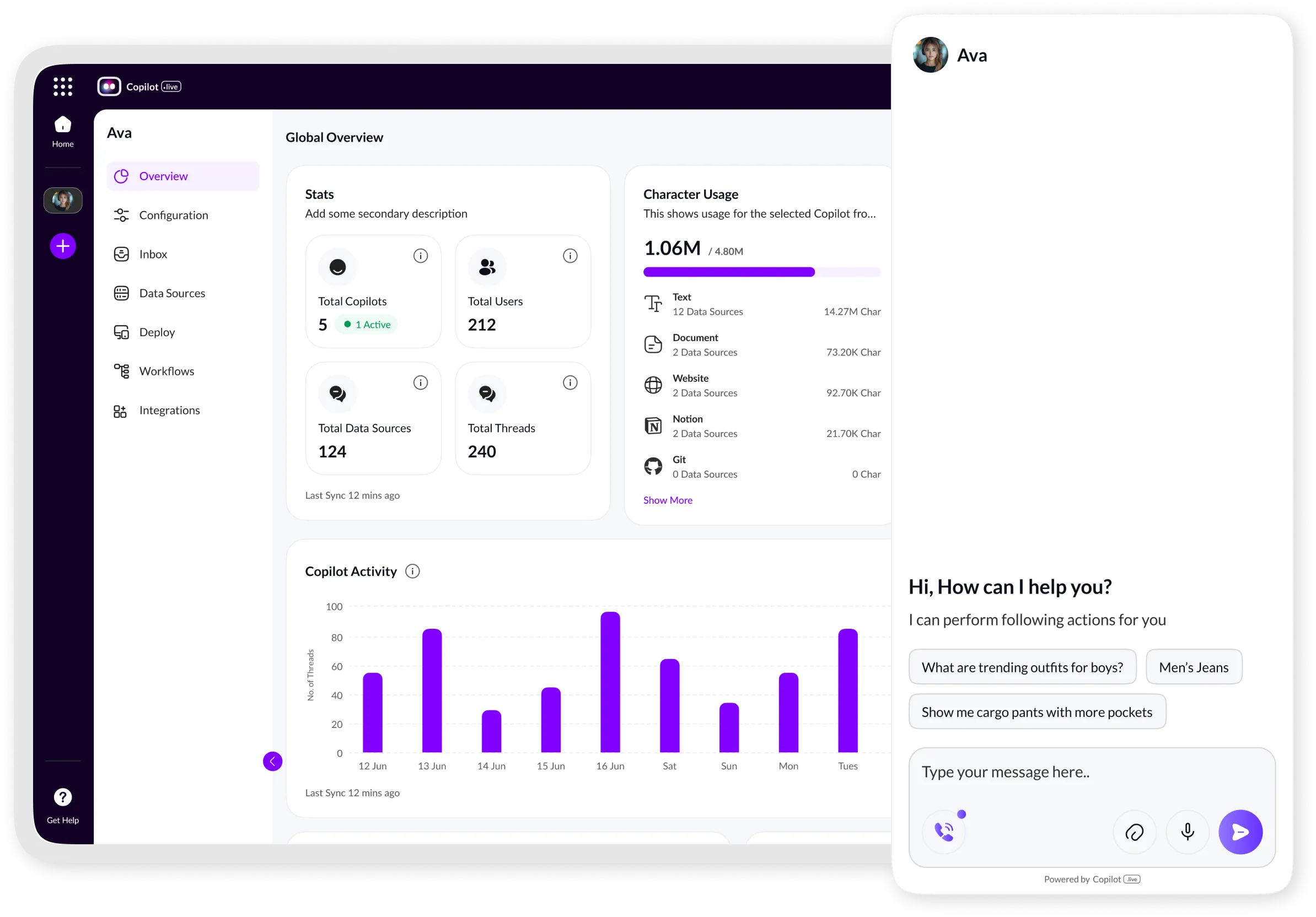
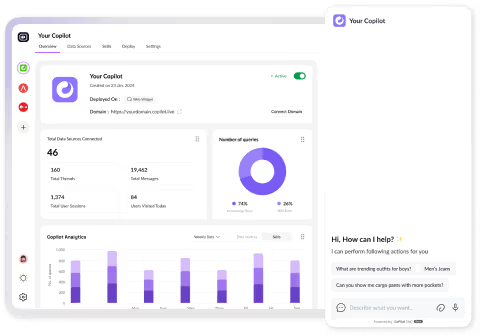
Create Chatbot For Gmail
Transform your productivity with Copilot.Live seamless integration of ChatBot and Gmail. Automate workflows effortlessly and boost efficiency. Start your free trial today and streamline your operations like never before.


Build an AI assistant in 3 minutes
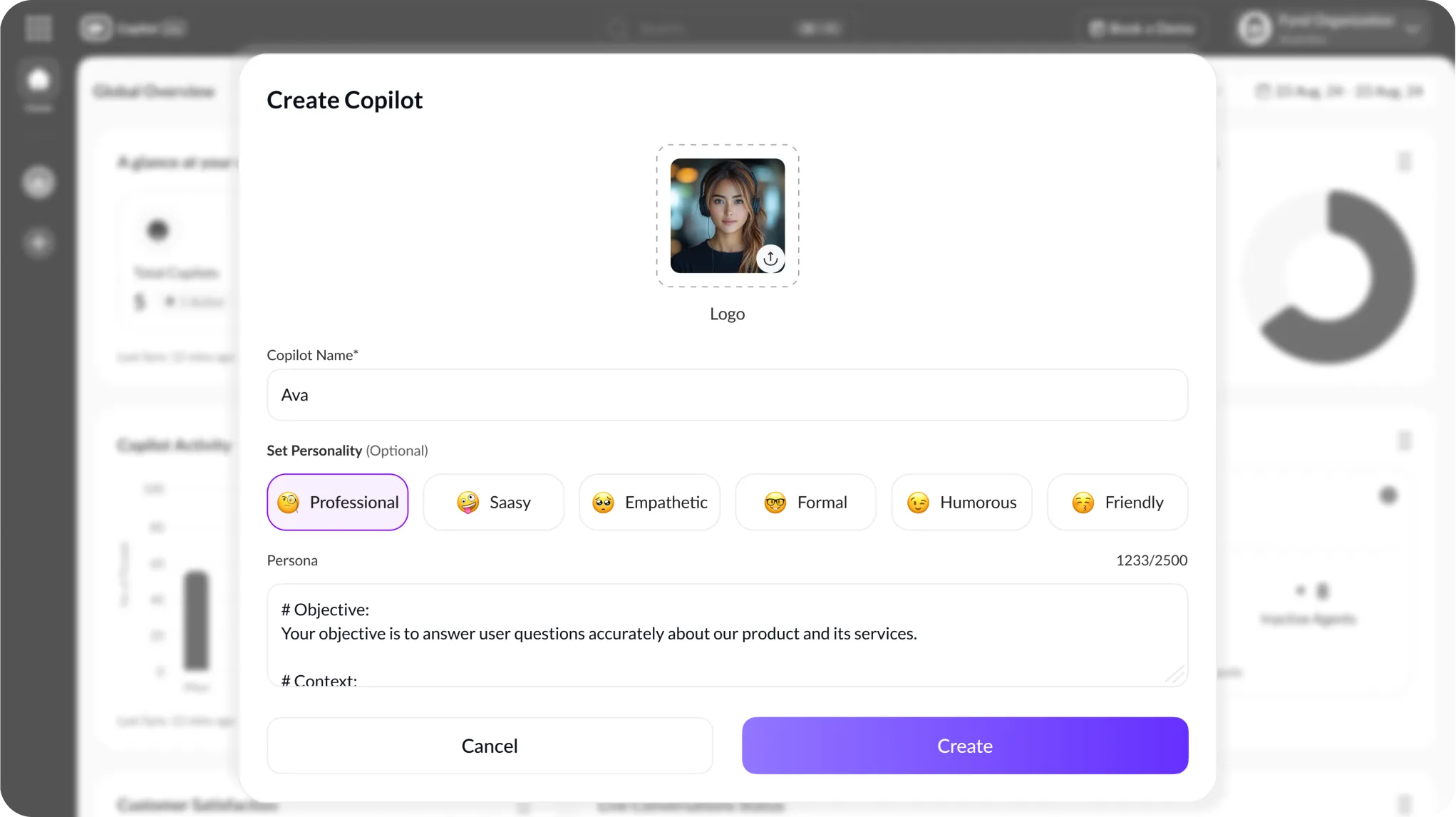
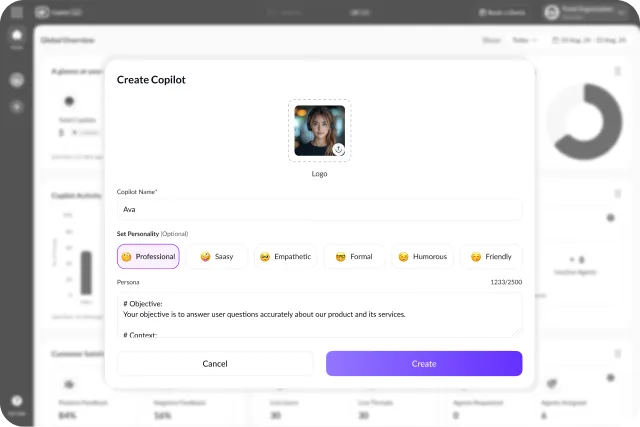

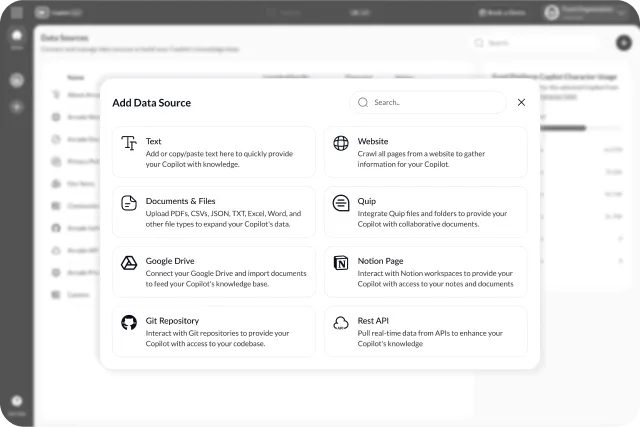

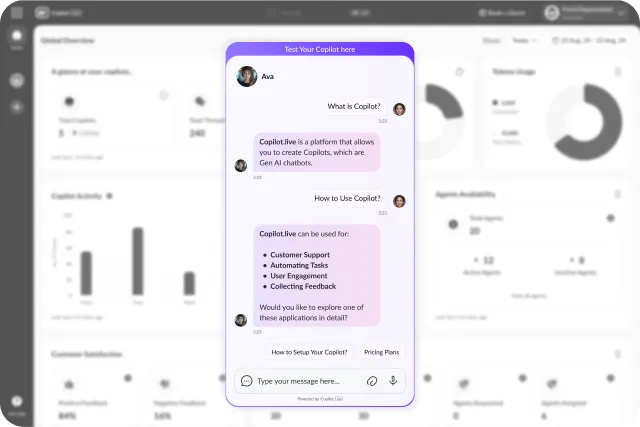
Create Your Chatbot In Four Simple Steps With Copilot.Live
Sign Up For Free
Begin your journey with Copilot.Live by signing up for a free account. Simply enter your email and get instant access to our powerful platform; no credit card is required.
Choose Your Bot Features
Customize your chatbot by selecting from a range of features and functionalities. Tailor it to meet your business needs, whether customer support, lead generation, or workflow automation.
Design Your Bot
Use our intuitive interface to design the conversation flow of your chatbot. Drag and drop elements to create engaging interactions that resonate with your audience, ensuring a seamless user experience.
Deploy And Monitor
Once you're satisfied with your chatbot design, deploy it across your preferred channels. Monitor its performance with real-time analytics, tweak as needed, and watch your bot enhance your operations.


Elevate Your Workflow With Copilot.Live Chatbot For Gmail Integration
Explore a new era of productivity with Copilot.Live Chatbot for Gmail integration. Revolutionize your workflow by streamlining communication and automating tasks seamlessly. With the power of Gen AI technology, manage email operations effortlessly and empower your team with self-service capabilities. Copilot.Live offers an intuitive chatbot builder, enabling you to create custom workflows tailored to your organization's needs.
Say goodbye to manual email handling and embrace efficient automation. Whether you're a small business streamlining operations or a significant enterprise scaling support, Copilot.Live ChatBot for Gmail is your solution. Join industry leaders who have harnessed the potential of our platform. Sign up now and discover the future of email management with Copilot.Live.
Why Choose Copilot.Live For Your Gmail Chatbot Needs?
Advanced Analytics1
Gain valuable insights into your chatbot's performance with Copilot.Live advanced analytics feature. Track user interactions, analyze conversation flow, and measure real-time engagement metrics. Identify trends, optimize workflows, and make data-driven decisions to enhance your bot's effectiveness and improve user satisfaction.
Multilingual Support
Expand your reach and cater to a global audience with Copilot.Live multilingual support feature. Easily configure your chatbot to communicate in multiple languages, ensuring seamless interactions with users worldwide. Break language barriers, deliver personalized experiences, and foster stronger connections with customers regardless of their language preferences.
Custom Integrations
Enhance the functionality of your chatbot by integrating it with third-party tools and services using Copilot.Live custom integrations feature. Connect with CRM, project management systems, or other software to streamline workflows and access additional data. Customize your bot's capabilities to meet specific business needs and leverage the power of synergistic integrations.
Conditional Logic
Create dynamic and responsive chatbot experiences with Copilot.Live conditional logic feature. Configure conditional statements to tailor conversations based on user input, context, or specific conditions. Personalize responses, guide users through complex workflows, and provide targeted assistance. With conditional logic, your chatbot can adapt intelligently to each user interaction, ensuring a seamless and satisfying experience.


Efficiency Unleashed With Copilot.Live Chatbotq Revolution
Enter the realm of unparalleled efficiency with Copilot.Live cutting-edge ChatBot solution. Seamlessly integrated with Gmail, our platform revolutionizes how businesses manage communication and automate tasks. From streamlining email operations to enhancing user experiences, Copilot.Live empowers organizations to optimize workflows and drive productivity. With Copilot.Live, you have the power to design custom chatbot workflows tailored to your unique requirements.
Whether automating customer support inquiries, facilitating employee self-service, or optimizing workflow processes, our platform offers unmatched flexibility and functionality. Picture a world where repetitive tasks vanish, productivity soars, and customer satisfaction reaches new heights. Copilot.Live transforms this vision into reality. Join the ranks of forward-thinking businesses already reaping the rewards of our Chatbot solution and embark on a journey towards unparalleled efficiency and success. Embrace the future of productivity with Copilot.Live Chatbot Revolution. Sign up now and unleash the full potential of your organization.
Key Features & Benefits Of Copilot.Live Chatbot For Gmail
Introducing Copilot.Live ChatBot Revolution: Streamline communication, automate tasks, and elevate productivity seamlessly. Experience unparalleled efficiency with our integrated solution tailored to revolutionize your workflow.
AI-Powered Suggestions
Empower your chatbot with AI-driven suggestions, enhancing user interactions and improving response accuracy. Copilot.Live advanced algorithms analyze user queries in real time, offering relevant suggestions to guide conversations and provide quick solutions. With AI-powered suggestions, your chatbot becomes more innovative and efficient, delivering personalized experiences and ensuring customer satisfaction.
Smart Routing Optimize
communication workflows with Copilot.Live innovative routing feature automatically directs incoming inquiries to the most appropriate channels or agents. By analyzing user intent and context, our platform intelligently routes messages to the correct department or individual, minimizing response times and improving efficiency. With intelligent routing, you can streamline customer support and processes and deliver seamless experiences across all touchpoints.
Contextual Awareness
Enhance the conversational experience with Copilot.Live contextual awareness feature enables your chatbot to understand and remember previous interactions. By retaining context from previous conversations, your chatbot can provide more relevant responses and anticipate user needs more effectively. Whether addressing complex queries or handling multi-step processes, contextual awareness ensures seamless continuity and fosters deeper user engagement.
Customizable Widgets
Elevate user engagement and brand presence with Copilot.Live customizable widgets. Tailor the design and functionality of chatbot widgets to align with your brand identity and user preferences. With various customization options, including colors, fonts, and layout, you can create a seamless integration that enhances the user experience and drives conversions.
Launch Your AI-Powered Chatbot For Gmail In No Time
Advanced Analytics
Advanced analytics involves using sophisticated techniques and tools to analyze complex data sets and extract valuable insights. Unlike traditional analytics, which primarily focuses on descriptive and diagnostic analysis, advanced analytics encompasses predictive and prescriptive analytics, enabling organizations to forecast future trends, identify patterns, and make data-driven decisions. By leveraging advanced statistical algorithms, machine learning models, and artificial intelligence, advanced analytics can uncover hidden relationships, optimize processes, and drive innovation. It empowers businesses better to understand their operations, customers, and market dynamics, ultimately leading to improved performance, competitive advantage, and strategic decision-making.
Seamless Integrations
Seamless integrations refer to the smooth and effortless connectivity between software applications, systems, or platforms. These integrations enable data flow, communication, and interaction without disruptions or complications, allowing users to transfer information seamlessly across various tools and services. Seamless integrations streamline workflows, enhance productivity, and improve collaboration by eliminating manual data entry, reducing errors, and automating repetitive tasks. Whether integrating CRM systems with email platforms, connecting project management tools with communication channels, or syncing databases with analytics platforms, seamless integrations ensure that all components work together harmoniously to maximize efficiency and optimize business processes.
User Authentication
User authentication is verifying an individual's identity attempting to access a system, application, or resource. It involves confirming that the user is who they claim to be before granting access to sensitive information or functionalities. Authentication methods commonly include passwords, biometric scans, security tokens, and multi-factor authentication (MFA). User authentication plays a critical role in ensuring the security and integrity of digital systems by preventing unauthorized access and protecting against identity theft, fraud, and data breaches. It forms the foundation of access control mechanisms and is essential for safeguarding user accounts, confidential data, and organizational assets online and offline.
Conditional logic
Conditional logic refers to the ability of a system or program to execute different actions based on specified conditions or criteria. It allows for decision-making within an automated process, where the outcome depends on the evaluation of certain conditions. Conditional logic typically involves using "if-then" statements, where if a particular condition is met, then a specific action or set of actions is performed; otherwise, alternative actions may be taken. This logic enables customization, flexibility, and dynamic behavior in applications, workflows, and algorithms. For example, in a chatbot, conditional logic can be used to route users to different responses based on their input, or in a workflow automation tool, it can determine which steps to execute based on the values of certain variables. Conditional logic enhances the efficiency, responsiveness, and adaptability of systems by allowing them to respond intelligently to varying scenarios and inputs.
Task Automation
Task automation refers to automating repetitive or manual tasks using technology, such as software programs, scripts, or robotic process automation (RPA) tools. It involves streamlining workflows, eliminating human intervention, and leveraging computing power to perform routine tasks more efficiently and accurately. Task automation can encompass many activities, including data entry, file management, report generation, email notifications, and more. By automating these tasks, organizations can save time, reduce errors, increase productivity, and free employees to focus on more strategic and value-added activities. Task automation is especially beneficial in repetitive, rule-based processes where human involvement is unnecessary, enabling organizations to achieve greater efficiency, consistency, and scalability in their operations.
Multi-Language Support
Multi-language support refers to the capability of a system, software application, or platform to accommodate and interact with users in multiple languages. This feature enables users from different linguistic backgrounds to access and engage with the system in their preferred language, enhancing inclusivity and accessibility. Multi-language support typically involves translations for user interfaces, content, messages, and prompts, allowing users to navigate and interact comfortably with the system in their native language. Additionally, it may include features such as language detection, language switching, and localization settings to adapt the user experience based on the user's language preference. Multi-language support is essential for global businesses, international websites, and applications serving diverse user bases, enabling them to reach a wider audience, improve user satisfaction, and effectively communicate across linguistic barriers.
Conversation History
Conversation history refers to a record or log of past user interactions between a system, such as a chatbot, messaging platform, or customer support tool. It stores a chronological sequence of messages, responses, and actions exchanged during previous conversations, allowing users and administrators to review past interactions for reference, analysis, or continuity purposes. Conversation history enables users to track the progress of ongoing discussions, recall past interactions, and retrieve relevant information or context from previous conversations. It also facilitates personalized communication by providing insights into the user's preferences, inquiries, and interactions over time. Additionally, conversation history aids system administrators in monitoring user engagement, evaluating performance, and improving the effectiveness of conversational experiences by identifying trends, patterns, and areas for optimization. Overall, conversation history is crucial in enhancing communication, collaboration, and user satisfaction in conversational interfaces.
A/B Testing
A/B testing, also known as split testing, is a method used to compare two versions of a webpage, email, app, or other digital asset to determine which one performs better. In A/B testing, two variants, A and B, are compared against each other by randomly assigning users to one of the two versions. The goal is to identify which variant yields better results regarding predefined metrics, such as click-through rates, conversion rates, or engagement levels. By measuring the performance of each variant, marketers, designers, and product managers can make data-driven decisions to optimize elements such as headlines, images, calls-to-action, layouts, or messaging. A/B testing allows for iterative improvements, incremental enhancements, and evidence-based optimization of digital assets to enhance user experience, drive conversions, and achieve business objectives.
Customizable Branding
Customizable branding refers to the ability of users to tailor the visual identity and design elements of a product, service, or platform according to their brand guidelines and preferences. This feature allows businesses and organizations to maintain consistency in their branding across all customer touchpoints, including websites, applications, emails, and other marketing collateral. With customizable branding, users can typically modify aspects such as colour schemes, typography, logos, icons, and stylesheets to align the user interface with their brand identity. This level of customization ensures that the user experience remains cohesive and reinforces brand recognition, trust, and loyalty among customers. Additionally, customizable branding empowers businesses to create a unique and memorable brand presence, differentiate themselves from competitors, and effectively communicate their brand values and personality to their target audience.
Role-Based Access Control
Role-based access control (RBAC) is a security model that governs access to resources based on the roles of individual users within an organization. In RBAC, permissions are assigned to roles rather than directly to users. Each user is assigned one or more roles, and each role is associated with a set of permissions that determine what actions the user can perform and what resources they can access. RBAC simplifies access management by centralizing permissions administration and enforcing the principle of least privilege, which restricts users to only the permissions necessary to perform their job responsibilities. This approach enhances security, reduces the risk of unauthorized access or data breaches, and streamlines access control administration by allowing administrators to manage permissions at the role level rather than individually for each user. RBAC is widely used in various systems, applications, and platforms to enforce access control policies and ensure data confidentiality, integrity, and availability.
Interactive Forms
Interactive forms are digital forms that allow users to engage with and input information dynamically and flexibly. Unlike static forms, interactive forms often include real-time validation, auto-fill suggestions, conditional logic, and interactive elements like checkboxes, radio buttons, dropdown menus, and sliders. These forms enhance user experience by providing immediate feedback, guiding users through the form completion process, and reducing errors. Interactive forms can adapt to user inputs, displaying or hiding fields based on previous selections, which streamlines the form-filling process and ensures relevant information is collected. Additionally, interactive forms may include features like progress indicators, tooltips, and error messages to assist users and improve form comprehension. Overall, interactive forms improve usability, increase completion rates, and facilitate data collection in various applications, including online surveys, registration forms, order forms, and more.
API Integration
API integration refers to connecting different software systems or applications through their application programming interfaces (APIs) to enable them to communicate and share data seamlessly. APIs define the methods and protocols for how different software components should interact with each other, allowing developers to access specific functionalities or data from one system to another. API integration enables systems to work together efficiently, automate processes, and share real-time information without manual intervention. It facilitates interoperability between diverse software systems, regardless of their underlying technologies or programming languages. Common examples of API integration include connecting a CRM system with an email marketing platform to sync customer data, integrating payment gateways with e-commerce websites for secure transactions, and linking social media platforms with analytics tools to track engagement metrics. API integration empowers organizations to leverage the capabilities of multiple systems, enhance workflow efficiency, and deliver seamless experiences to users.
Data Encryption
Data encryption is converting plaintext data into ciphertext, making it unreadable to anyone who needs the appropriate decryption key. This cryptographic technique ensures that sensitive information remains secure and confidential, even if intercepted by unauthorized parties. Encryption algorithms use mathematical functions to scramble the data, rendering it indecipherable without the corresponding decryption key. Encrypted data can only be decrypted and restored to its original form by authorized users with the decryption key. Data encryption is essential for protecting sensitive information such as personally identifiable information (PII), financial records, intellectual property, and communication channels from unauthorized access, interception, or tampering. It is widely used in various applications, including secure communication protocols, data storage systems, cloud computing, and mobile devices, to safeguard data privacy and prevent breaches. Strong encryption algorithms and robust encryption essential management practices are critical to a comprehensive data security strategy.
Performance Monitoring
Performance monitoring is the process of tracking, analyzing, and evaluating the performance of systems, applications, or processes to ensure they meet predefined performance objectives and standards. It involves continuously collecting and measuring various performance metrics, such as response times, throughput, resource utilization, and error rates, to assess the monitored components' efficiency, reliability, and availability. Performance monitoring tools and techniques provide real-time insights into system behavior, identify performance bottlenecks, and detect anomalies or deviations from expected performance levels. By monitoring performance metrics over time, organizations can identify trends, anticipate potential issues, and optimize system performance to enhance user experience, minimize downtime, and improve overall operational efficiency. Performance monitoring is crucial in various domains, including IT infrastructure management, application development, network performance optimization, and cloud computing, to ensure optimal performance, scalability, and reliability of critical systems and services.
Natural Language Understanding
Natural language understanding (NLU) is a branch of artificial intelligence (AI) that focuses on enabling computers to comprehend and interpret human language in a meaningful way. It involves the development of algorithms and models capable of processing and understanding unstructured text or speech data, such as emails, social media posts, articles, or spoken conversations. NLU algorithms analyze the syntactic, semantic, and contextual aspects of language to extract relevant information, infer meaning, and derive insights from natural language inputs. By leveraging techniques such as machine learning, deep learning, and natural language processing (NLP), NLU systems can perform tasks such as sentiment analysis, entity recognition, intent detection, language translation, and question answering. NLU plays a crucial role in various applications, including virtual assistants, chatbots, sentiment analysis tools, information retrieval systems, and language translation services, enabling more intuitive human-computer interactions and facilitating the automation of language-based tasks.


Empower Your Workflow With Copilot.Live Chatbot Solution
Seamlessly integrated with Gmail, our platform redefines how businesses manage communication, automate tasks, and enhance user experiences. With Copilot.Live, you can streamline email operations, empower employees with self-service capabilities, and optimize workflow processes. Designed for simplicity and effectiveness, our Chatbot solution offers unparalleled flexibility and functionality.
Whether you're looking to automate customer support inquiries, streamline internal processes, or engage users in personalized interactions, Copilot.Live has you covered. Experience the power of automation and elevate your workflow to new heights with Copilot.Live ChatBot solution. Join hundreds of forward-thinking businesses benefiting from our platform and revolutionize how you engage with your audience. Discover a world of efficiency and innovation with Copilot.Live. Sign up now and unleash the full potential of your organization.
What Does A Chatbot For Gmail Need To Know?
A Chatbot for Gmail needs to possess several key capabilities to enhance email operations and streamline communication processes effectively. Firstly, it should be able to access and analyze Gmail messages, including reading, sending, and managing emails. This entails understanding various email formats like text, attachments, and HTML content. Additionally, the Chatbot should be equipped with intelligent parsing capabilities to extract relevant information from emails, such as sender details, subject lines, and message content. This enables the Chatbot to categorize emails, prioritize tasks, and trigger appropriate responses based on predefined criteria. Furthermore, the Chatbot must support natural language processing (NLP) to understand user queries and respond appropriately.
Whether retrieving information from emails, scheduling appointments, or performing actions within Gmail, the Chatbot should interpret user intent accurately and execute tasks seamlessly. Moreover, integration with external applications and services is crucial for extending the Chatbot's functionality and automating workflow processes. This includes integrating task management tools, calendar apps, CRM systems, and other productivity software to enable seamless collaboration and task automation. Overall, a Chatbot for Gmail should possess a comprehensive set of features that enable it to interact intelligently with email messages, understand user requests, and automate tasks effectively, ultimately enhancing productivity and efficiency in email communication.


Frequently Asked Questions
You can reach out to us in case of any queries, feedback, or suggestions via [email protected] or read below.
A. Copilot.Live ChatBot solution is an advanced platform that integrates seamlessly with Gmail to automate email operations, enhance employee self-service, and streamline workflow processes.
A. The ChatBot for Gmail leverages artificial intelligence and natural language processing to read, interpret, and respond to emails intelligently. It can perform tasks such as sorting emails, answering queries, scheduling appointments, etc.
A. Some benefits include increased productivity, reduced manual workload, faster response times, improved customer service, and enhanced collaboration among team members.
A. Yes, Copilot.Live ChatBot for Gmail has features for handling sensitive data securely, ensuring compliance with data protection regulations and maintaining confidentiality.
A. Yes, businesses can customize the ChatBot for Gmail to suit their specific needs, including defining workflows, setting up automated responses, and integrating with other applications.
A. Absolutely, Copilot.Live ChatBot for Gmail supports seamless integration with various third-party applications and services, enhancing functionality and workflow automation.
A. Setting up the ChatBot for Gmail is straightforward and user-friendly with Copilot.Live intuitive interface and guided setup process users can quickly configure the ChatBot to start automating email tasks.
A. Yes, Copilot.Live provides dedicated customer support to assist users with questions, technical issues, or customization needs related to the ChatBot for Gmail.
A. While primarily designed for business use, the ChatBot for Gmail can also be adapted for personal email accounts, providing similar automation and productivity benefits.
A. Yes, Copilot.Live offers a free trial period for users to explore the features and capabilities of the ChatBot for Gmail before committing to a subscription.









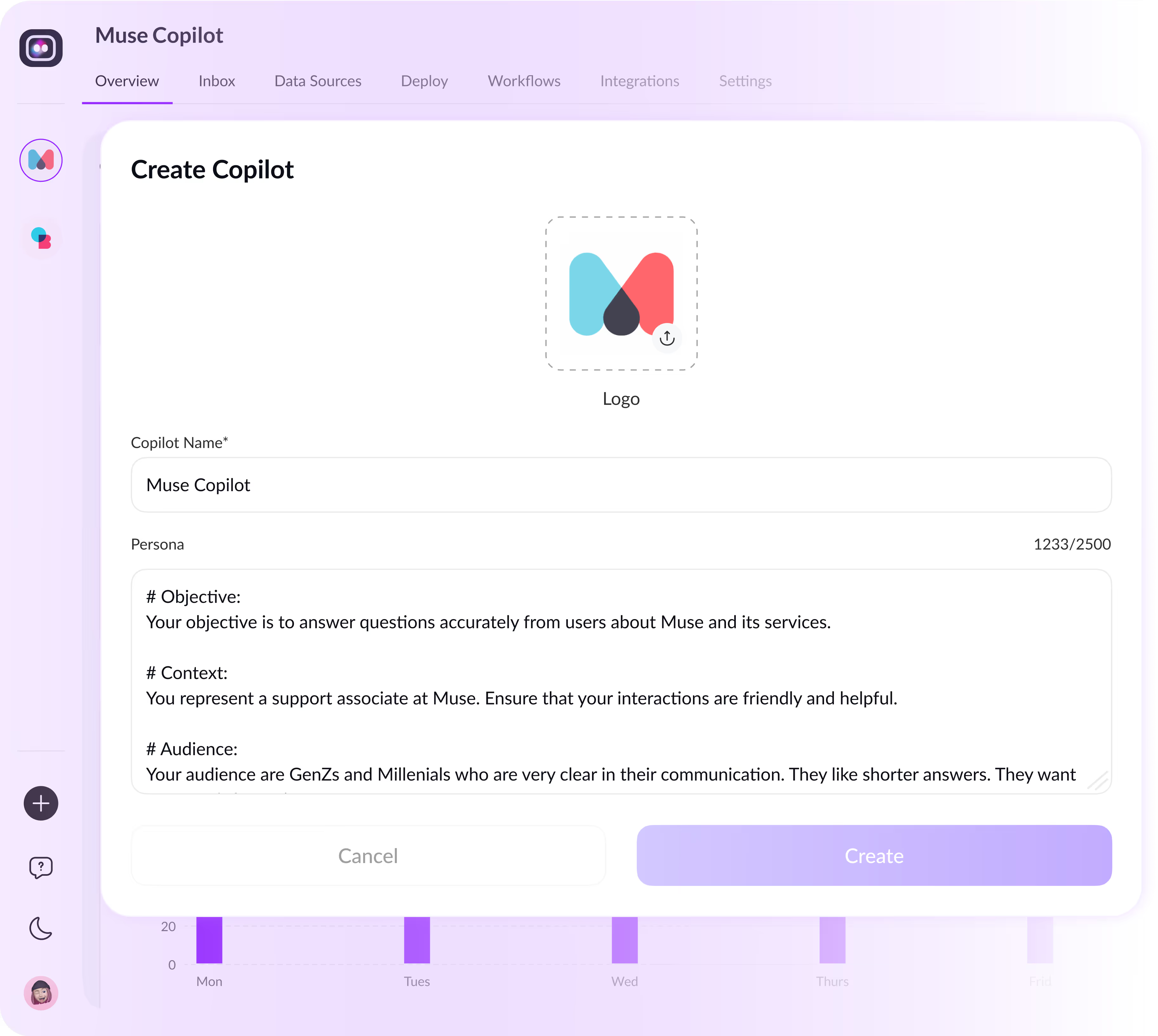
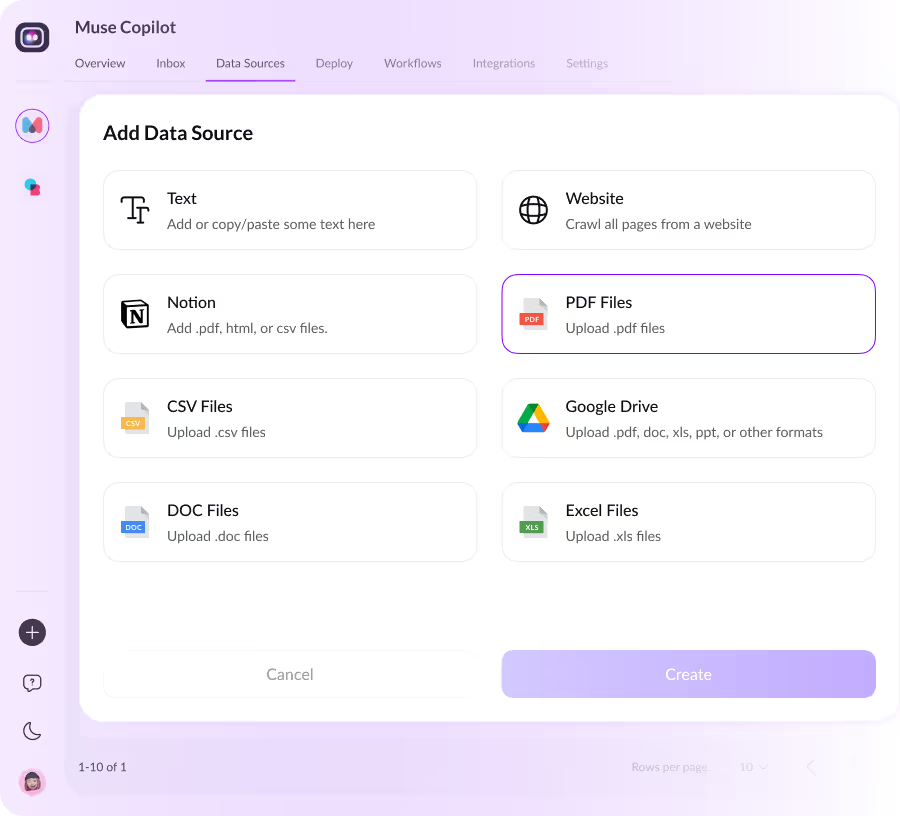






.avif)



.avif)
.avif)

.avif)
.avif)
.avif)











































